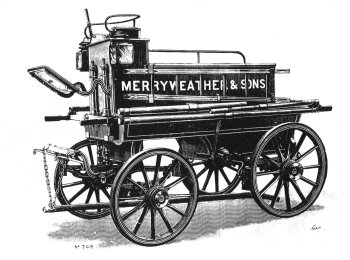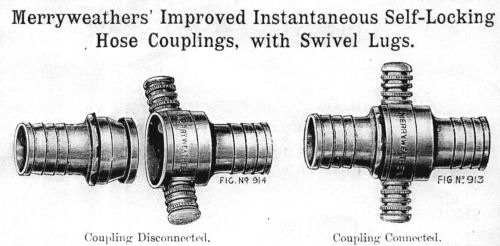|
Equipment
|
||||||||||||||||
|
The
engine selected by Broadway Parish Council, and supplied by Merryweather
& Sons, was a Greenwich Manual (see illustration below). By the
end of the 19th Century steam powered fire pumps were preferred by larger
fire brigades. But for parish brigades like Broadway a manual pump was
still the best option. The purchase price and running costs of a manual
machine were much less than those of a steamer. The Greenwich Manual,
an improved version of their 1851 London Bridge pattern, could, according
to Merryweather, deliver 146 gallons of water per minute, and project
a jet to a height of 125 feet. As a comparison a modern fire pump will
deliver approximately 400 gallons per minute. It was described as being
for 26 men. This number was presumably made up of three crews of eight
who took turns in pumping, leaving two men to deal with the hoses. The
body was constructed of mahogany with a large locker for hoses and other
equipment. Two gunmetal pumps were operated by the side handles via
wrought iron levers. Riding on four large wooden wheels with steel leaf
springs it was light enough to be hauled at a gallop by two horses.
|
||||||||||||||||
|
A
comprehensive set of equipment was also purchased with the engine including
suction hose with a basket strainer for drawing from open water, four
lengths of delivery hose and one branchpipe. There were twelve canvas
buckets which were probably used as an alternative method of supplying
water to the pump. A pair of ladders was attached to the sides of the
engine. (list
of equipment)
The pump was put through its paces in November 1901 when Edgar Flower, who had given the money to buy the engine, asked the brigade to bring it to his home, Middle Hill House. It proved powerful enough to direct a jet over the highest chimney of the house. There was insufficient suction hose to reach his basement water tanks, so Mr. Flower asked the Parish Council to order further lengths for which he agreed to pay. Mr. Flower, understandably, wanted to ensure that the equipment he had so generously provided for the village, would be able to fight a fire at his home, should the need arise. |
||||||||||||||||
 A Merryweather Greenwich manual, similar to the one supplied to the Broadway brigade. |
||||||||||||||||
|
Various
other small items of equipment were added over the years, including
an axe, shovel, and hand lamps. In 1902 James Martin, captain of the
brigade at the time, asked for a hand cart, but the request was refused
by the Parish Council on several occasions due to cost. As Martin must
have pointed out, the brigade could have turned out with the hose and
other equipment on a hand cart much more quickly than with the fire
engine. This may, at first, seem like a backwards step, but for small
incidents close to the station where the hose could be connected directly
to a hydrant it would have been especially useful. A cart was eventually
purchased in 1919 for the sum of £3:15s.
|
||||||||||||||||
 From Merrweather's catalogue c.1900 |
||||||||||||||||
|
Soon
after the formation of the brigade attention turned to providing some
method of calling out the crew in the event of a fire. A bell was thought
to be of little use due to the difficulty of distinguishing it from
the many other bells in the village. John Morris, the clerk to the Parish
Council wrote to Merryweather asking them to send a powerful foghorn
on approval. Merryweather & Sons replied that a fog horn would not
be suitable. This would have been because of the lack of any power supply.
They suggested instead a large bell, or an electric telegraph connected
to the firemen’s homes.
|
||||||||||||||||
|
The
clerk then canvassed the opinion of other brigades in the area. All
those who replied were currently using a hand operated bell situated,
in most cases, on top of their station. The general feeling of the other
brigades was, that although not an ideal way of raising the alarm, a
bell served the purpose fairly well. The Moreton-in-Marsh captain suggested
the use of electrical alarms connected to the men's homes. He found
that their bell, when sounded, attracted a crowd of onlookers, who in
his words, "Are at times a hindrance to prompt work".
Finally, though, the council decided on a bell rather than the electric
telegraph, presumably because the latter would have been too expensive.
A quote of £4:16:6d was obtained from T.W.Coke of Sheerness for
a 14" bell and 40' of tufted rope, and it was agreed it should
be ordered. Gill Brothers of Bourton-on-the-Hill quoted £7:15s
to construct a tower on the fire station to house the bell; this quote
was also accepted by the council.(see
proposed bell tower)
|
||||||||||||||||
|
Providing
horses to haul the fire engine was as much a problem for the Broadway
brigade as it was for other small brigades. It would have been prohibitively
expensive to buy and keep horses solely for this purpose. Instead, they
had to rely on having an agreement with someone to supply horses as
and when required. The Broadway brigade’s horses were at first
supplied by Robert Cordell, proprietor of the Lygon Arms, who was captain
of the brigade at the time. Charles Stuart Drury of Mill Hay in Snowshill
Road provided them from about 1901 until 1904 when John Cotterell, one
of the firemen, assumed responsibility. John Cotterell continued to
provide horses for the next fifteen years, until 1919.
There then followed a period when it was not possible to get anyone to make a definite commitment to supply horses to the Brigade. Mr. Roberts of the Swan Inn said he would do his very best to provide them if called upon. But this situation was clearly unsatisfactory, so in 1921 an iron towing bar was fitted to the fire engine. This enabled it to be hauled to fires behind various motor vehicles which were, at that time, becoming more common. The first recorded instance of motor haulage is by means of a vehicle supplied by Broadway Garage, to a fire at Mr. Galt's of Kite's Nest in 1921. So ended the era of the horse drawn engine, and the uncertainty over haulage. |
||||||||||||||||
|
The
change from horses to motor haulage removed one more source of complaint
from the local critics who, of course, were always on hand to find fault.
There is a story, handed down with some amusement, about the horses
having to be rounded up from a field on the hill, and about the resultant
lengthy delay in turning out whilst the firemen chased them around the
field. This story may or may not be true, but, in fact, turnout times
were often quite good. For instance, on a dark January evening in 1903,
it is recorded that the brigade was able to hitch the horses, and get
mobile to a fire just twenty minutes after the alarm was raised.
|
||||||||||||||||